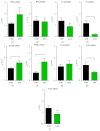Activation of Endocannabinoid System Is Associated with Persistent Inflammation in Human Aortic Aneurysm
- PMID: 26539497
- PMCID: PMC4619808
- DOI: 10.1155/2015/456582
Activation of Endocannabinoid System Is Associated with Persistent Inflammation in Human Aortic Aneurysm
Abstract
Human aortic aneurysms have been associated with inflammation and vascular remodeling. Since the endocannabinoid system modulates inflammation and tissue remodeling, we investigated its components in human aortic aneurysms. We obtained anterior aortic wall samples from patients undergoing elective surgery for aortic aneurysm or coronary artery disease as controls. Histological and molecular analysis (RT-qPCR) was performed, and endocannabinoid concentration was determined using LC-MRM. Patient characteristics were comparable between the groups except for a higher incidence of arterial hypertension and diabetes in the control group. mRNA level of cannabinoid receptors was significantly higher in aneurysms than in controls. Concentration of the endocannabinoid 2-arachidonoylglycerol was significantly higher, while the second endocannabinoid anandamide and its metabolite arachidonic acid and palmitoylethanolamide were significantly lower in aneurysms. Histology revealed persistent infiltration of newly recruited leukocytes and significantly higher mononuclear cell density in adventitia of the aneurysms. Proinflammatory environment in aneurysms was shown by significant upregulation of M-CSF and PPARγ but associated with downregulation of chemokines. We found comparable collagen-stained area between the groups, significantly decreased mRNA level of CTGF, osteopontin-1, and MMP-2, and increased TIMP-4 expression in aneurysms. Our data provides evidence for endocannabinoid system activation in human aortic aneurysms, associated with persistent low-level inflammation and vascular remodeling.
Figures





References
-
- Hiratzka L. F., Bakris G. L., Beckman J. A., et al. 2010 ACCF/AHA/AATS/ACR/ASA/SCA/SCAI/SIR/STS/SVM guidelines for the diagnosis and management of patients with thoracic aortic disease: executive summary. A report of the American College of Cardiology Foundation/American Heart Association Task Force on Practice Guidelines, American Association for Thoracic Surgery, American College of Radiology, American Stroke Association, Society of Cardiovascular Anesthesiologists, Society for Cardiovascular Angiography and Interventions, Society of Interventional Radiology, Society of Thoracic Surgeons, and Society for Vascular Medicine. Catheterization and Cardiovascular Interventions. 2010;76(2):E43–E86. doi: 10.1002/ccd.22537. - DOI - PubMed
-
- Loeys B. L., Schwarze U., Holm T., et al. Aneurysm syndromes caused by mutations in the TGF-beta receptor. The New England Journal of Medicine. 2006;355(8):788–798. - PubMed
-
- Nkomo V. T., Enriquez-Sarano M., Ammash N. M., et al. Bicuspid aortic valve associated with aortic dilatation: a community-based study. Arteriosclerosis, Thrombosis, and Vascular Biology. 2003;23(2):351–356. - PubMed
Publication types
MeSH terms
Substances
LinkOut - more resources
Full Text Sources
Other Literature Sources
Medical
Research Materials
Miscellaneous

